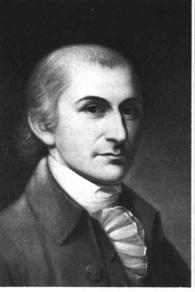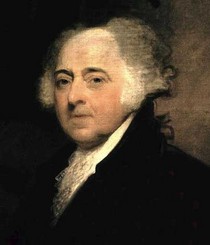Light snow dusted the
cobbled streets of Paris as carriages pulled up to the Hotel
d'Orleans on the Rue des Petis-Augustines, where the American, John
Jay, had arranged to commence treaty negotiations with England on
October 30, 1782. (for more, click here)

This and subsequent
sessions commenced at 11 o'clock each morning. Negotiating
for the new republic were John Jay, John Adams (who had three weeks
before concluded a treaty of commerce with the Dutch at the Hauge),
and Benjamin Franklin, who represented the United States to the
French throughout the War of Independence.
As secretary
for the American commissioners, Franklin selected his grandson,
William Temple Franklin, the twenty-two year old illegitimate son
of Franklin's illegitimate son, William, the former Tory governor
of New Jersey who was then living in London. Also in
attendance were Franklin's longtime friend and associate, a British
spy named Bancroft, and the young French hero of the American
Revolution, the Marquis de Lafayette, recently arrived home from
North America.
(Click here for more on this treaty)
The fundamental
questions to be dealt with in the treaty negotiations were: the
boundaries of the United States; the right of navigation on the
Mississippi; debts; the interests of American Tories and Loyalists;
and American fishing rights on the Grand Banks off
Newfoundland.
The Americans insisted that Britain cede all territory
between the Appalachian Mountains on the east, and the Mississippi
River on the west. Britain agreed to this demand, "thus at a
stroke doubling the side of the new nation."

The preliminary
draft of the treaty was signed on November 30, 1782. Richard
Oswald, representing England, was first to sign, followed by the
four Americans.
The final
document would be signed at the Hotel d'York on the Rue
Jacob. Again, the signatures would be fixed in the customary
order, Adams, Franklin, Jay, along with that of the King's new
representative, David Hartley. The all important first
sentence of Article I declared "His Britannic Majesty acknowledges
the said United States…to be free, sovereign and independent
states." Then, the last line read "Done at Paris, this third
day of September, in the year of our Lord, one thousand seven
hundred and eighty three."
Just a few miles away, and some
twenty years later, another agreement would be struck that would
'change the known world' by more than doubling the geographic area
of the new nation. In the first treaty, Britain sought to
separate the Americans from their French allies. In the
second, France's Napoleon sought to separate Americans from their
British cousins.
The treaty at Paris was as
advantageous to Americans as any in history, and the American
negotiators were received at home as heroes.